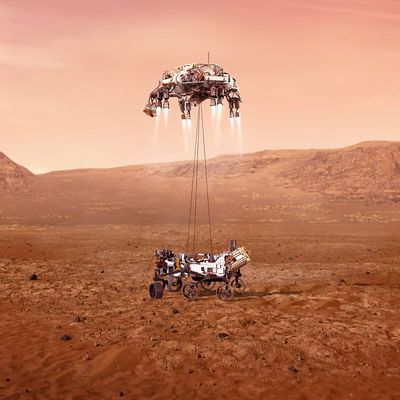
Though a pandemic may be ravaging the country and most of Texas has been plunged into the 19th century, America can still do one thing right: Shoot a robot into space.
Having blasted off in July on a 293-million-mile sojourn to the Red Planet, NASA’s Perseverance rover finally touched down on Mars on Thursday. Back on Earth, engineers watched nervously as Perseverance autonomously plowed into the Martian atmosphere at speeds reaching 12,100 mph and performed the high-wire act dubbed by engineers the “seven minutes of terror” — the entry, descent, and landing phases of the mission — making a beeline to touch down in a hazard-laden crater. (The drama was made all the more stressful by the 11-minute lag in communications between the planets.)
“It is amazing to have Perseverance join Curiosity on Mars,” NASA acting administrator Steve Jurczyk said after the landing. “What an amazing team to work through all the adversity and challenges that go with landing a rover on Mars, plus the challenges of COVID.”
Now that the red dust has settled, the SUV-size robot emissary will seek signs of ancient life in a location known as Jezero Crater that is widely believed to have been home to an ancient riverbed. If life once existed on Mars, a spot like Jezero Crater would have been ideal for microbes to hang out. The rover will attempt to capture humanity’s first cache of Martian soil samples in airtight lipstick-size containers, which could return back to Earth as early as 2031. “Samples from Mars have the potential to profoundly change our understanding of the origin, evolution, and distribution of life on Earth and elsewhere in the solar system,” Lori Glaze, who directs NASA’s Planetary Science Division, said during a news conference last month.
Although Perseverance superficially looks a lot like Curiosity, its predecessor, the lab on wheels is carrying a bevy of new scientific instruments. A ground-penetrating radar will be the first rover instrument to look under the surface of Mars, mapping layers of rock, water, and ice up to 33 feet deep; another instrument will attempt to extract oxygen from Mars’s thin, mostly-carbon-dioxide atmosphere.
Perseverance also has a helicopter, the Ingenuity, that is expected to become the first aircraft to attempt a powered, controlled flight on another planet. If the 4.5-pound chopper works as hoped, engineers likely will design more capable drones that could fly instruments and cameras to targets inaccessible to rovers and astronauts.
The mission is planned to last for at least one Mars year, which works out to about 687 days on Earth. But if the long-lived Curiosity and Opportunity missions are any indication, we can expect to get a lot more science from Percy.





























